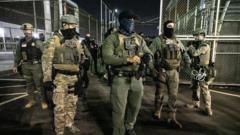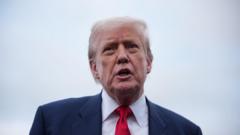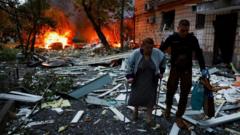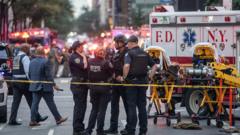In a bold move, President Donald Trump has ordered an expansive increase in the detention and deportation of migrants amid rising protests against his strict immigration policies. Using his platform Truth Social, Trump urged federal agencies to initiate "the single largest mass deportation programme in history," pinpointing major cities such as Los Angeles, Chicago, and New York as the focal points for this effort.
Trump Expands Deportation Initiative Amid Nationwide Protests

Trump Expands Deportation Initiative Amid Nationwide Protests
President Trump intensifies his immigration crackdown as protests erupt across the country.
The announcement comes in the wake of widespread demonstrations against Trump’s approach to immigration, particularly since June 6, when protests surged over federal raids targeting undocumented individuals. These cities have experienced significant unrest, with activists rallying against the administration’s stances. Trump, amidst legal battles and public criticism regarding the deployment of military forces to suppress protests, stated he had directed "the entire administration to put every resource possible behind this effort." He underscored his commitment to preventing "anyone who undermines the domestic tranquility" from entering the United States.
Trump's directive supports agencies like the Drug Enforcement Administration (DEA) and Immigration and Customs Enforcement (ICE), declaring his full backing for their efforts: "you have my unwavering support. Now go, get the job done!" This move coincided with a renewed wave of protests, particularly marked by the recent “No Kings” movement, which has seen demonstrators occupying spaces from Los Angeles to New York. Tragedy struck during a No Kings event in Salt Lake City, Utah, where a shooting resulted in one fatality.
The president's edict sheds light on his focus on sanctuary cities—localities that restrict their cooperation with federal immigration enforcement, which have become battlegrounds in the federal-state tension over immigration laws. Despite Trump pushing for more deportations, sanctuary city officials maintain their stance on upholding legal protections for undocumented migrants.
This intensification of deportation efforts aligns with Trump’s longstanding campaign promise to implement the "largest deportation programme of criminals in the history of America." While opinion polls indicated that many voters supported this hardline stance as the 2024 elections approach, the ongoing protests suggest significant dissent among the populace. The new directive follows a brief pause directed earlier for raids at various workplaces, indicating the volatility of the administration’s approach to immigration enforcement.
Trump's directive supports agencies like the Drug Enforcement Administration (DEA) and Immigration and Customs Enforcement (ICE), declaring his full backing for their efforts: "you have my unwavering support. Now go, get the job done!" This move coincided with a renewed wave of protests, particularly marked by the recent “No Kings” movement, which has seen demonstrators occupying spaces from Los Angeles to New York. Tragedy struck during a No Kings event in Salt Lake City, Utah, where a shooting resulted in one fatality.
The president's edict sheds light on his focus on sanctuary cities—localities that restrict their cooperation with federal immigration enforcement, which have become battlegrounds in the federal-state tension over immigration laws. Despite Trump pushing for more deportations, sanctuary city officials maintain their stance on upholding legal protections for undocumented migrants.
This intensification of deportation efforts aligns with Trump’s longstanding campaign promise to implement the "largest deportation programme of criminals in the history of America." While opinion polls indicated that many voters supported this hardline stance as the 2024 elections approach, the ongoing protests suggest significant dissent among the populace. The new directive follows a brief pause directed earlier for raids at various workplaces, indicating the volatility of the administration’s approach to immigration enforcement.




















